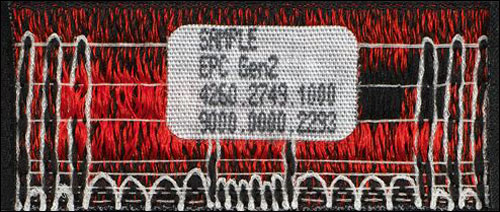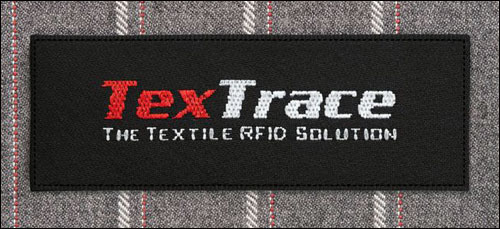Apr 10, 2012A European manufacturer of luxury apparel is preparing to test a woven fabric RFID label on its garments, in order to determine whether it can improve inventory visibility, as well as prevent theft. The small fabric RFID label, made by TexTrace, provides an alternative to the paper hangtags or adhesive labels commonly employed for the item-level tracking of apparel and other consumer goods. It can be sewn directly onto a product, survive washes and remain largely invisible as an RFID tag. Although there are other textile tags that are sewn into products, says Sybille Korrodi, TexTrace's marketing head, these lack the look and feel of a high-value woven label, and are bulkier than TexTrace's version, which can be designed with a form factor to meet a user's needs, but can be as small as approximately 2 inches by 0.75 inch.
The TexTrace label has a built-in EPC Gen 2 passive ultrahigh-frequency (UHF) G2iL RFID chip from NXP Semiconductors, with a protective pad and a stitched-in antenna consisting of what the company calls "electronically sensitive yarn" (Korrodi declines to name the material used, citing patents), and visible only on the label's back side. TexTrace designed its label for such applications as brand protection (preventing the counterfeiting of high-value products), inventory accuracy, electronic surveillance (with an RFID reader portal at a store's door) and customer-service features, such as interactive mirrors.
The protective pad, made of a stiff textile material, is bonded to the label, providing protection for the chip module underneath it against any damage that could occur during the wash process. The pad measures about 0.7 inch by 0.4 inch.
TexTrace's labels are being custom-made for the luxury apparel manufacturer, with the brand name and logo displayed on the front, enabling the firm to replace the brand's existing product label. However, Korrodi says, the labels could also be sewn into goods at the factories during manufacture. The labels are tough enough to withstand such processes as stone washing and bleaching, the company reports, as well as subsequent laundering or dry-cleaning after a customer purchases the tagged goods.
Once attached, the label authenticates the product, since the unique ID number encoded to the label's RFID chip could be linked in a database to the brand company and the product's stock-keeping unit (SKU), confirming its authenticity. Readers installed at a store's doorway would read the ID encoded to the tag, which has a read range of up to approximately 6 meters (19.7 feet), thereby thwarting any attempt to steal that product. The goal, according to the company, is that potential thieves would be reluctant to cut the label off an item in an effort to carry that product past the readers undetected, since the item would lose its value without the brand label.
TexTrace is currently incorporating NXP's G2iL chip into its label, though it could employ any standard UHF chip as well, Korrodi says. "We are flexible to integrate chips from different manufacturers," she states.

The company expects luxury apparel brands to represent the majority of early adopters, since they typically are vertically integrated. The companies could have the labels attached at the point of manufacture, then read the tags throughout the supply chain and into stores, for the purpose of managing inventory. They could also set up RFID readers at the point of sale, as well as at doors, to enable purchases via RFID and prevent theft.
In addition, the tags can be utilized to improve the efficiency of returns, and to verify the authenticity of a product by reading its tag. What's more, a tag could be deactivated using a kill command at the point of sale (as is the case with any UHF tag), upon a consumer's request.
According to TexTrace, the trials being launched by the unnamed European luxury-apparel manufacturer will include reading tags for inventory tracking, as well as at the doorways of two of the company's stores, initially.



